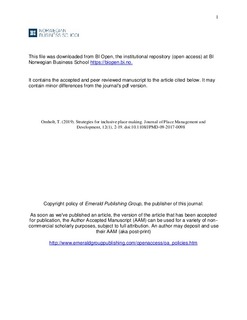Strategies for inclusive place making
Journal article, Peer reviewed
Accepted version
Permanent lenke
http://hdl.handle.net/11250/2609363Utgivelsesdato
2019Metadata
Vis full innførselSamlinger
- Publikasjoner fra CRIStin - BI [1015]
- Scientific articles [2181]
Originalversjon
Journal of Place Management and Development. 2019, 12 (1), 2-19. 10.1108/JPMD-09-2017-0098Sammendrag
Purpose – The purpose of this paper is to present a new approach to analyzing place making structure and processes, and discuss strategies for inclusive place making in urban areas.
Design/methodology/approach – The theoretical approach is based on social systems theory and organization design theory, representing a constructionist and socio-structural approach to inclusive place making. The methodology is based on a comparative analysis of three cases of inclusive place making.
Findings – The main findings are that place making systems today lack the necessary complexity in their politics and planning to secure inclusive place making and fail to organize for face-to-face interactions in place making processes.
Research limitations/implications – In a social systems approach we observe how place stakeholders and systems observe place making realities and problems, and construct place images. This introduces some degree of uncertainty into our analyses, but constitutes an effective basis for studying inclusive strategy development.
Practical implications – The findings indicate that observing how place stakeholders construct their opinions about the problems and possibilities for inclusive place making and face-to-face interactions, probably constitutes the best basis for practical support for inclusive place making.
Social implications – The paper directs attention to the fact that current urban development strategies and policies towards inclusion of groups with limited resources today lack the necessary knowledge bases and means to deal effectively with the complexity related to current inclusion problems.
Originality/value – The paper demonstrates that an approach, which supplements the basic governance systems with face-to-face interactions, can deal effectively with today’s problems of inclusivity.
